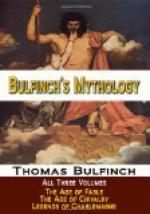At a time when chivalry excited universal admiration, and when all the efforts of that chivalry were directed against the enemies of religion, it was natural that literature should receive the same impulse, and that history and fable should be ransacked to furnish examples of courage and piety that might excite increased emulation. Arthur and Charlemagne were the two heroes selected for this purpose. Arthur’s pretensions were that he was a brave, though not always a successful warrior; he had withstood with great resolution the arms of the infidels, that is to say of the Saxons, and his memory was held in the highest estimation by his countrymen, the Britons, who carried with them into Wales, and into the kindred country of Armorica, or Brittany, the memory of his exploits, which their national vanity insensibly exaggerated, till the little prince of the Silures (South Wales) was magnified into the conqueror of England, of Gaul, and of the greater part of Europe. His genealogy was gradually carried up to an imaginary Brutus, and to the period of the Trojan war, and a sort of chronicle was composed in the Welsh, or Armorican language, which, under the pompous title of the “History of the Kings of Britain,” was translated into Latin by Geoffrey of Monmouth, about the year 1150. The Welsh critics consider the material of the work to have been an older history, written by St. Talian, Bishop of St. Asaph, in the seventh century.
As to Charlemagne, though his real merits were sufficient to secure his immortality, it was impossible that his holy wars against the Saracens should not become a favorite topic for fiction. Accordingly, the fabulous history of these wars was written, probably towards the close of the eleventh century, by a monk, who, thinking it would add dignity to his work to embellish it with a contemporary name, boldly ascribed it to Turpin, who was Archbishop of Rheims about the year 773.
These fabulous chronicles were for a while imprisoned in languages of local only or of professional access. Both Turpin and Geoffrey might indeed be read by ecclesiastics, the sole Latin scholars of those times, and Geoffrey’s British original would contribute to the gratification of Welshmen; but neither could become extensively popular till translated into some language of general and familiar use. The Anglo-Saxon was at that time used only by a conquered and enslaved nation; the Spanish and Italian languages were not yet formed; the Norman French alone was spoken and understood by the nobility in the greater part of Europe, and therefore was a proper vehicle for the new mode of composition.




